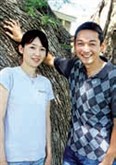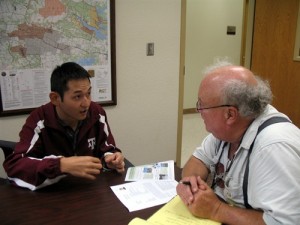Studying Little River
July 2010
Japanese hydrologist is part of exchange program at Blackland
By Harper Scott Clark- Published June 17, 2010
TELEGRAM STAFF WRITER
The Little River watershed is providing scientific data that will help a visiting hydrologist manage a watershed in his native Japan.
Dr. Hiroaki Somura, 34, is working with Dr. Dennis Hoffman of the Texas A&M Blackland Research and Extension Center and Dr. Jeff Arnold with the U.S. Department of Agriculture as part of an international exchange program.
The project they monitor has a long name – Analysis on Influences of Agricultural Activities in the Little River Watershed to a Downstream Lake Water Environment Under Global Warming Conditions.
Somura, who goes by the nickname Hiro among his colleagues, said as part of his work he collects water samples from the major lakes, rivers and streams that flow into the Little River watershed. He analyzes them for nutrient and sediment concentration along with information regarding crop production and animal production.
A Soil and Water Analysis Tool computer model (called SWAT for short) has been established to conduct the study, he said.
Among the project’s goals are determining current agricultural practices and hydrologic conditions in the Little River watershed and estimating the impact of climatic shifts on river quantity and quality.
Somura, who is an assistant professor at Shimane University in Japan, first came to the Blackland Research Center five years ago to work on the project in its infancy. He liked what he saw. So he applied for a return visit on a grant through an agency of the Japanese government.
The Little River study is complex, Somura said. It involves the effects on the Little River watershed of two lakes – Stillhouse Reservoir and Lake Belton – two rivers – the Leon River and the Lampasas River – and Salado Creek.

Dr. Hiroaki Somura with his wife, Chikako –Photo by Harper Scott Clark
Somura said when he returns home he will apply the SWAT model developed here to his own community around Matsue City. Two lakes there straddle the city – Lake Shinji to the west and Lake Nakaumi to the east. The region borders the Sea of Japan.
Somura said Lake Nakaumi, which is fed by the ocean, is salty – about 50 percent saline. And Lake Shinji is brackish, about 10 percent saline. A narrow channel connects the two.
To the south, the Ibi River runs out of the mountains and flows into Lake Shinji. Along the river where it cuts through the mountains, locals have been farming in terraced rice paddies for centuries. In the flat lowlands near Matsue rice paddies are even more abundant.
The similarities between Bell County and Shimane are evident, but the differences place them worlds apart in topography and the type of farming. Rice paddies hold water. Farms and ranches shed water.

Dr. Somura explains his research and project goals. –Photo courtesy of Blackland Research Center
The SWAT model Somura will take home from Texas will work in managing the watershed to maintain water quantity and quality, he said.
One of the main concerns for quality is to protect the Shijimi clam that resides in Lake Shinji and is a great delicacy in Japan. Forty percent of the Shijimi clams sold in Japan come from Lake Shinji, so it is vital to maintain salinity levels and water quality.
Somura’s wife, Chikako (Chika for short), accompanied Somura on this visit. She is a biologist by training. He said the two met at Shimane University five years ago and were drawn together by their mutual love and respect for science.
Dr. Thomas Gerik, director for the Blackland Research Center, said a group of scientists from Temple have been sent to Japan as part of the exchange program.
–Reprinted with permission of Temple Daily Telegram
